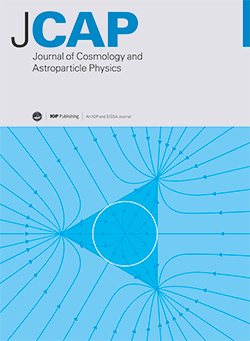Dilaton generation in propagation of magnetic dipole waves of pulsar in a galactic magnetic field
IF 5.9
2区 物理与天体物理
Q1 ASTRONOMY & ASTROPHYSICS
Journal of Cosmology and Astroparticle Physics
Pub Date : 2024-11-29
DOI:10.1088/1475-7516/2024/11/066
引用次数: 0
Abstract
This study is devoted to dilaton generation during the propagation of magnetic dipole waves from a pulsar in the galactic magnetic field. Dilaton generation occurs at cosmological scales on the order of the coherence lengths of the galactic magnetic field Lcoh, approximately 100 pc. The exact solutions of the dilaton field equation in a vacuum and in the interstellar medium with reflective index n = 1 + χ, χ ≪ 1 have been obtained, and the angular distribution of emitted dilaton energy has been determined in both cases. It has been shown that the dilaton generation intensity at first increases proportionally to r2, where r is distance from the neutron star to the observation point, then has oscillating behavior. The obtained results are applicable only for r < Lcoh. For a millisecond pulsar with a magnetic field BS ∼ 109 Gauss, located at a distance from Earth on the order of the coherence length of the galactic magnetic field Lcoh ∼ 100 pc, the obtained intensity of the dilaton generation can be greater in 100 times than the analogous intensity produced by rotating magnetic dipole momentum of a pulsar. Based on estimated values, the impact of pulsar and magnetar gravitational fields on magnetic dipole wave radiation is minimal and changes the amplitude of the waves by around 1 percent. For this reason, the effect of the gravitational field on the dilaton formation process can be disregarded in this study.脉冲星磁偶极子波在星系磁场中传播时的膨胀子产生
本研究致力于研究脉冲星磁偶极子波在星系磁场中传播时的膨胀子产生。膨胀子的产生发生在宇宙尺度上,其量级与银河系磁场的相干长度Lcoh相当,大约为100pc。得到了真空和反射率n = 1 + χ, χ≪1的星际介质中的膨胀场方程的精确解,并确定了两种情况下发射的膨胀能的角分布。研究表明,膨胀产生强度首先与r2成比例增加,其中r为中子星到观测点的距离,然后具有振荡行为。所得结果仅适用于r < Lcoh。对于磁场为BS ~ 109高斯的毫秒脉冲星,其距离地球的距离相当于银河系磁场的相干长度Lcoh ~ 100pc,所获得的膨胀子产生的强度可以比脉冲星旋转磁偶极子动量产生的类似强度大100倍。根据估计值,脉冲星和磁星引力场对磁偶极子波辐射的影响很小,并且将波的振幅改变了约1%。因此,本研究可以忽略引力场对膨胀形成过程的影响。
本文章由计算机程序翻译,如有差异,请以英文原文为准。
求助全文
约1分钟内获得全文
求助全文
来源期刊

Journal of Cosmology and Astroparticle Physics
地学天文-天文与天体物理
CiteScore
10.20
自引率
23.40%
发文量
632
审稿时长
1 months
期刊介绍:
Journal of Cosmology and Astroparticle Physics (JCAP) encompasses theoretical, observational and experimental areas as well as computation and simulation. The journal covers the latest developments in the theory of all fundamental interactions and their cosmological implications (e.g. M-theory and cosmology, brane cosmology). JCAP''s coverage also includes topics such as formation, dynamics and clustering of galaxies, pre-galactic star formation, x-ray astronomy, radio astronomy, gravitational lensing, active galactic nuclei, intergalactic and interstellar matter.
 求助内容:
求助内容: 应助结果提醒方式:
应助结果提醒方式:


